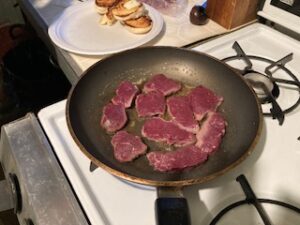Salt Pork In the Pan

BY V. Paul Reynolds
Frankly, I never gave too much thought to the role of salt pork in cooking, outdoors or indoors. I do recall that my mother used it once in awhile when she made fish chowder or baked beans. It had to be part of my vocabulary, though, because I slipped some salt park in a verse that I penned more than 50 years ago for my hunting club’s official song: “In Hastie’s hut we map our day, to slaughter those whitetails as they play. Our food is bad and our water is worse, but venison soon will grace our fork sauted gently with a little salt pork.”
In 60 years of marriage, salt pork never made it to the V. Paul Reynolds kitchen, not ever! Diane, my beloved late wife, who was very health conscious, especially about salt and saturated fat, declared salt pork off limits, persona non grata, in her kitchen, almost the day after I carried her across the threshold at the U.S. Navy MOQ (married officer quarters.) Later in our marriage, when I took to baking beans every Saturday night, the culinary demons got a hold on me. When Diane spied the chunk of salt pork stacked upon on the kitchen table with the molasses, brown sugar and dry mustard, she hit the roof. The salt pork wound up in the trash. You would think that I had conspired to slip strychnine into the bean pot!
The Ultimatum
Flash forward 60 years. For whatever reason, salt pork is creeping into the conversation. A friend, whose culinary skills are formidable, recently told me that he would not come to my house for my newly honed fish chowder unless I made it with salt pork! Another friend of French heritage who grew up in the St. John Valley, told me last week that porc sale was a mainstay in his family’s diet. He recalls that salt pork was even used to flavor the boiled string beans. “ My grandfather, who lived to be in his late 80s, cooked fat back and ate it,” he recalls.
Last week during a very successful three-day trout fishing trip, my host, Lagrange outdoorsman and bush flyer Tommy Russell, got out his over- sized, long-handled skillet and cooked brookies and pan- fried potatoes over an open fire. And guess what? Before the trout and taters every hit the pan, he sizzled up some stripped chunks of salt pork. Looking on, I could sense my late wife cringing.
Now brook trout or venison backstraps browned up in a buttered iron skillet, which has been my way of cooking these two favorites for more than a half century, was always the ONLY way to my way of thinking. Now after consuming my share of Tommy Russell’s fried-in-salt-pork brookies, I may have to rethink my iron- skillet cooking orthodoxy.
If my bride were here, she would counsel me with references from the experts. She would go to Google:
1. High in Saturated Fat
-
Salt pork is very fatty, mostly composed of pork fat with some streaks of meat.
-
High in saturated fat, which can raise LDL (“bad”) cholesterol levels if consumed frequently and in large amounts.
2. Extremely High in Sodium
-
As the name suggests, salt pork is packed with salt.
-
Sodium content is very high, which may raise blood pressure and stress the cardiovascular
system — especially problematic for those with heart disease or hypertension.
A fellow I know, who takes nothing seriously, had this to say:
“Salt pork is like the scrappy grandfather of bacon—tough, salty, and always up at dawn making everything taste better whether it wants to or not. In the old days, it was the duct tape of frontier cooking: slap it in the beans, drop it in the chowder, grease the skillet with it—heck, some folks probably used it to shine their boots. It doesn’t just flavor food; it intimidates it into tasting better. Just don’t nibble on it raw unless you enjoy chewing rubber bands dipped in ocean water.”
For articles about hunting, fishing and the great outdoors be sure to subscribe to the Northwoods Sporting Journal.
